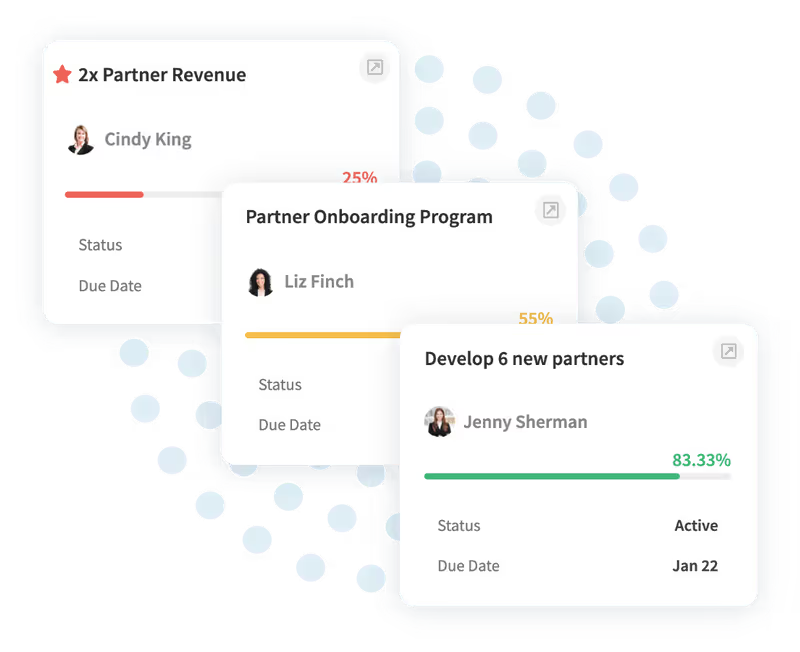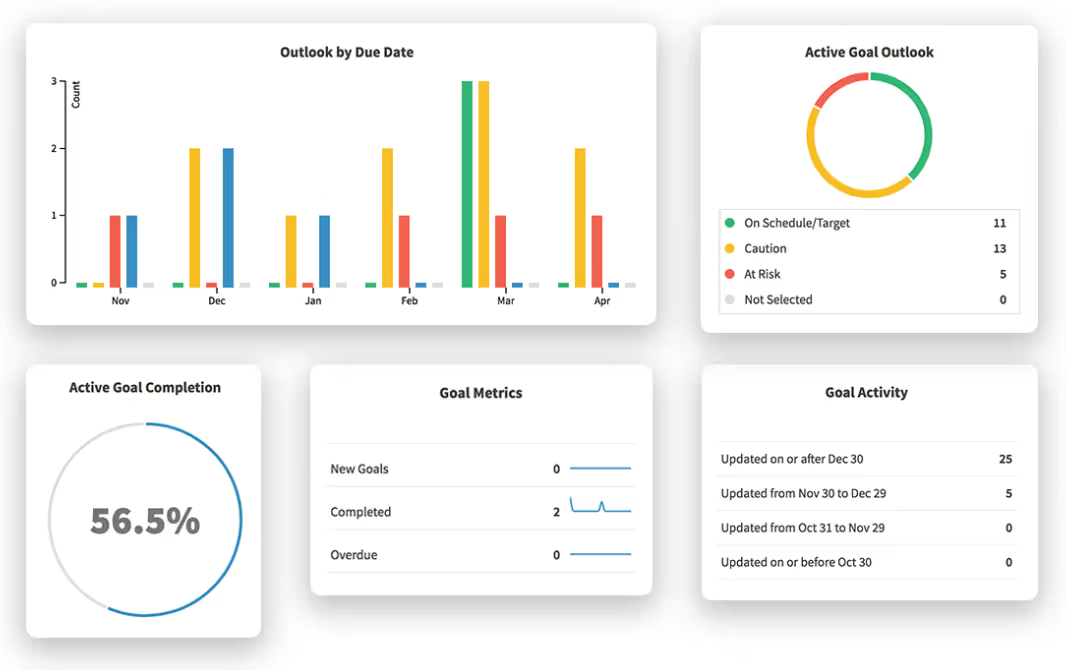Employee Goal Setting: The Only Guide You'll Ever Need
Goals are important because they allow us to look to the future. When goals are properly aligned with an organization’s goals, everyone can work towards the same thing.
But relying on employees to come up with their own goals isn’t enough. A whopping 80 percent of people do not set goals for themselves, and among the 20 percent that do, only 30 percent of them achieve those goals.
That’s because setting reasonable goals can be a lot for anyone to wrap their head around. It is doable when you’re armed with the right information, and you give your employees support along the way.
The following guide on employee goal setting includes everything you need to know. It will help you create aligned, challenging, and quantifiable goals for your organization.
What Is Employee Goal Setting?
Employee goal setting is meant to help employees align their behaviors with organizational goals. This leadership performance management strategy focuses on aligning personal goals with organizational goals. The idea is to achieve multiple outcomes that impact the individual, the teams they work on, and the organization.
It’s not just the organization that benefits from company-wide goal setting. Setting goals also benefits employees.
Why Does Goal Setting Benefit Employees?
The importance of goal setting for employees is about organizational success, but it’s also important to employees.
Workers are increasingly seeking value and purpose at work. Three-quarters of employees believe feedback is valuable. 92 percent of respondents in one survey said that constructive criticism improves performance.
Employees want goals. They allow everyone to see how they can positively impact the organization. They lay the foundation for employees to receive recognition for a job well done.
In a broader sense, goals help employees grow, personally and professionally. They can change the way employees view work, and it can give workers a sense of control over their future within the company.
At the end of the day, setting challenging, yet achievable, goals leads to 90 percent better performance. Better performance leads to more recognition. More recognition leads to better engagement. This creates a cycle of enhanced performance that benefits every employee and the organization.
How Can I Align Employee Goals With Corporate Objectives
The first step in creating performance goals for employees is identifying your organization’s goals. From there you can set cascading goals for each department, each team within each department, and each individual on each team. This ensures that corporate objectives are always top-of-mind when creating goals at any level of the organization.

To make sure goals continue to align with corporate objectives, you have to allow employees to see how they're doing in real-time, which includes making metrics available so everyone can see exactly how they are contributing to team, departmental, and organizational goals.
Click here to learn more about how to align employee goals with corporate objectives.
What Types of Goals Can Be Used for Employee Goal Setting?
Part of what makes setting goals in a professional setting so challenging is the fact that not all goals are created equal. There are different types of goals you can choose from, and which kind of goals you choose will depend on the needs of your organization.
Let’s start with SMART goals first
SMART goals
SMART goals are smart because they are specific, measurable, achievable, relevant, and time-constrained. Everything you need to achieve the goal is outlined clearly, which means you’re more likely to reach your goal.
There is no ambiguity with SMART goals. Employees know exactly what goal they are setting out to achieve, how to achieve it when to achieve it, and they’ll know exactly when it has been achieved.
Employee goal-setting examples using the SMART goal-setting system go beyond an initial idea. For example, the goal might be to get more clients. But, will you have achieved your goal with just one client, or do you need multiple clients? If you get one client by the end of the year, will you have achieved your goal? And how are you going to get more clients?
Setting a SMART goal to get more clients would sound like this:
Get five new clients this quarter by conducting at least two customer meetings a week.
Part of what makes SMART goals achievable is their detailed nature, but it’s that detail that can make tracking SMART goals difficult.
That’s where a system like PerformYard comes in.
SMART goal-setting software provides you with one place where goals can be tracked. They can quickly and easily be accessed ahead of a performance review, and employees have access to their information at any time.
Learn more about the importance of setting SMART goals here.
Alternatives to SMART goals
SMART goals are popular in many different organizations, but that doesn’t mean it’s your only option. There are plenty of alternatives to SMART goals out there.
We mentioned cascading goals earlier, but it’s worth mentioning again. Whether you’re setting SMART goals or you’ve got your sights set on a specific OKR, it’s always a good idea to use a cascading framework that starts at the top. This ensures that your biggest, most important organizational goals are used to create all other goals, ensuring everyone is aligned with your company’s main objectives.
Other employee goal-setting options include:
- OKRs enable you to articulate a goal, even if its measurability isn't clear
- MBOs allow employees and managers to create goals collaboratively
- Role-specific goals are consistent across all employees with the same role
- Team-specific goals are consistent across all employees who are members of the same team
- Individual growth goals focus on each employee and can include personal and/or professional goals
Stretch goals
SMART goals, and many other types of employee goals, rely on the fact that goals should be challenging, yet achievable. If a goal seems too difficult, employees aren't going to feel motivated to achieve it.
But, there is a different way to approach setting goals. They are called stretch goals.
These types of goals encourage 10x thinking, which means trying to improve something by 10 times rather than thinking small and trying to improve that same thing by 10 percent. This type of goal encourages rethinking an approach or rethinking the problem itself instead of simply trying to improve what you're already doing.
It can make a goal seem outrageously unachievable at first, but with continued determination, amazing things can happen. Innovative companies like Google approach goals this way, which is why Google is always at the forefront of modern innovation.
Learn more about stretch goals here.
How Do I Implement Employee Goal Setting in the Workplace
Implementing employee goal-setting in the workplace can seem like an impossible task. It can indeed take a lot of time and dedication, but it is achievable when you break the process down into separate steps that include:
- Set goals consistently across the organization
- Set similar goals based on roles
- Set unique goals based on growth
- Follow the SMART goal framework
- Check-in with employees frequently to see if goals will be met
- Reward employees who achieve their goals
- Spend more time with employees who fall short

Set goals consistently across the organization
You have to identify organizational goals as part of the cascading goals process, but we encourage you to start at the top, no matter what kind of goal structure you choose. You can ensure everyone’s goals work together when you start by identifying common goals across the organization first.
Set similar goals based on roles
You don’t have to reinvent the wheel for every single employee. Instead of diving into individual goals right away, work on setting similar goals based on everyone’s roles. By having a set of goals that are appropriate for different departments and/or roles within those departments, you can save time and still set meaningful goals for your team.
Set unique goals based on growth
After setting role-based goals, employees should be able to help develop their own unique goals. Brainstorm goals that are focused on growth. That includes professional growth within the organization, but it might also mean personal growth in their career.
Follow the SMART goal framework
Once you have identified appropriate goals, it’s a good idea to make sure they fit within the SMART goal framework. That way each employee has the exact information they need to achieve their goals.
Check-in with employees frequently to see if goals will be met
Don’t wait until the next official review to talk about goals. You should make time to talk to your team about their goals throughout the process of achieving them. Having regular check-ins gives employees the chance to talk about their wins as they’re happening, and it allows them to work with managers to alter goals or request support if needed.
Reward employees who achieve their goals
It’s not enough to make sure employees are meeting their goals at their official review. You also have to make sure employees know that you’re proud of their achievements. Reward employees for meeting their goals, whether their reward is a bonus, extra time off, or a promotion, and they will be motivated to continue reaching their goals in the future.
Spend more time with employees who fall short
If you have employees who haven’t met their goals, don’t just send them on their way with new ones. Managers need to spend more time with employees who struggle, not as a disciplinary measure, but as a supportive one. By working together, you can provide additional training, professional development, and mentorship that can help those employees reach their goals next time.
What is an example of employee goal setting?
Employee goal setting is a strategic approach designed to align the individual objectives of employees with the broader objectives of an organization. By setting clear and structured goals, employees are given a roadmap that they can follow to achieve their professional aspirations, while also contributing to the company's success. Employee goal examples create a performance framework that drives productivity and accountability within a workspace.
Example of a SMART Goal for an Employee: Increase Quarterly Sales by 15%
A prime example of a strategic goal setting method is the SMART framework, which stands for Specific, Measurable, Achievable, Relevant, and Time-bound. Consider an objective like 'Increase quarterly sales by 15%'. Here, the specificity lies in the precise increase (15%), it is measurable through sales reports, achievable given the employee's access to resources, relevant to the company's financial performance, and time-bound within a single quarter.
Annual Goal-Setting Example: Complete Comprehensive Training Course by Year-End
In contrast, annual goals take a long-term view. An example is having an employee complete a comprehensive training course by year-end. This objective supports skill development and contributes to professional growth. It reflects a commitment to the employee's ongoing development while ensuring the company gains from a more skilled workforce.
Emphasizing the Alignment with Organizational Objectives
It is critical that individual performance goals for employees examples be closely aligned with organizational objectives. When employee goals reflect the strategic aims of the organization, it ensures coherence in efforts, enhancing overall productivity and helping in achieving corporate milestones. It also fosters a sense of unity and shared purpose among employees, driving engagement and motivation.
What are the 4 general types of employee goals?
Understanding the different types of employee goals is integral to unlocking potential and aligning individual efforts with the broader organisational vision. Each category of goals plays a significant role in ensuring that a company doesn't just meet its performance benchmarks but exceeds them.
Performance goals
These goals are aimed at enhancing job performance and output. They focus on specific deliverables and meeting job role requirements. For instance, a goal might be to increase sales targets by 20% within the next quarter. Well-structured performance goals ensure that employees remain focused on what is expected of them and continually push toward bettering their output.
Development goals
Development goals serve to grow the skills and competencies of employees. They often involve activities such as completing a course, attending professional workshops, or learning a new software tool. These goals are crucial for personal and professional growth, enabling employees to adapt to changing roles and responsibilities over time.
Team goals
Team goals are designed to encourage collaboration and teamwork. They focus on the collective efforts of a group to achieve a shared objective. This might involve projects like developing a new product or improving a specific process. Effective team goals foster communication within teams, improve synergy, and ensure that everyone is rowing in the same direction.
Personal goals
Personal goals align individual values with organizational objectives. These can be highly motivating as they resonate deeply with the individual’s own desires, such as improving work-life balance or preparing for a future leadership role. Personal goals enable employees to see their personal aspirations mirrored in their professional roles, thereby deepening engagement and satisfaction.
These types of goals collectively ensure that an organization not only meets its immediate demands but is also strategically geared for long-term success. With PerformYard's easy-to-use software, businesses can seamlessly track and align these goals from the organizational level down to each individual employee. By integrating goal setting with organizational vision and long-term objectives, businesses can ensure that they are poised for strategic growth.
What Are the Challenges With Employee Goal Setting?
Knowing potential issues ahead of time regarding goal setting can help you avoid those pitfalls. Potential employee goal-setting challenges include:
- Unclear goals that don’t address every aspect of the SMART goal system
- Unattainable goals that employees don’t have the knowledge or the training to achieve
- Goals without a clear timeline make it difficult for employees and managers to pace themselves
- Goals that aren’t role-specific, which means they may not be aligned with daily duties
How Can Employee Goal Setting Be Used With Performance Management?
Employee goal setting is a worthwhile endeavor by itself. It can be even more effective when used with a broader performance management system.
A performance management system uses a review cycle that helps managers see how their employees are doing individually and as part of a team. Incorporating goals can be a great way for employees to take ownership of their performance. It gives both employees and managers a transparent way to determine whether performance objectives are being met.

The key is building a performance management system that incorporates employee goal-setting that’s unique to your organization. With PerformYard, you can customize a system of goal setting, check-ins, and formal reviews. It will integrate analytics and feedback in ways that will help your organization achieve greater success.



.jpg)

